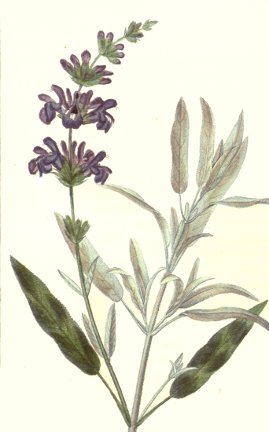 Salvia officinalis
Salvia officinalisSage, Organic
Both Culpeper and Cunningham consider this a Jupiter herb. Its leaves do in fact contain tin, which is Jupiter's metal, and for rites of purification, it is a traditional substitute for less widely available frankincense. But some believe it is a Moon herb, perhaps because of the bluish bloom on the dried herb, which many Moon plants have, that it was traditionally ingested to start menstruation, and that it was used for divination, a typically Moon endeavor, in ancient Greece (words were written on the leaves, which were exposed to the wind; what the wind left behind was interpreted). An infusion of the flowers is considered to be especially helpful in developing clairvoyance. We tend to think of sage as an Earth herb, though, because of its scent and because Wiccans usually associate this herb with Samhain and Crone, both of which are associated with Earth. This Element is connected with the Hermit's Path,
Mundane Uses
Sage was used in cooking long before it was ever a medicinal herb. The
ancient Romans loved it with fatty foods, since not only does it taste
good but it helps the digestion. Just as sage can be used magickally
for either uncovering or for hiding, as a tea it also has opposite
effects--when drunk cold, it is diuretic, and when drunk warm, it
causes sweating. However, if you drink sage tea, don't use it for more
than two weeks at a time, as it can build up toxicity in the body. Also, sage
can lower the seizure threshold. Like
many bitter herbs, it helps rid the body of worms and other parasites,
but it was also a traditional anaphrodisiac. It makes nice wreaths--a
great way to inconspicuously protect your home is with a sage wreath on
the front door--and is a fine strewing herb that repels bugs. Sage is also known as common, kitchen, or garden sage,
and as Salbei,
Echter Salbei, Gartensalbei, ryytisalvia, rohtosalvia, salvia,
kryddsalvia, sauge, and salvia real.
How to Grow Sage
Germinates in 7-21 days at room temperature. Transpant 12" apart to full sun or partial shade (makes a nice woodland plant) . Soil can be a bit rocky but not acidic (don't plant next to pine trees or blueberries). It prefers some sand in the soil and no standing water at all. Sage is a perennial in zones 4-8 (temperate areas) but not in extreme heat. This plant gets 16-30" tall. Bees enjoy the flowers, but for the strongest herb, harvest the leaves before the plant flowers. This herb is a traditional companion plant for cabbages and other cole crops as well as carrots, but it dislikes being near wormwood, rue, cukes, or squash. General growing info
Salvia officinalis
Organic Sage
30 seeds
$3.50
Go to the dried herb
Uses in Witchcraft & Magic:
Purification Rituals
Protection
Spells
Divination
Crone Work
Celebrating Samhain
Hermit's
Path
Jupiter/Moon/Earth Herb
© 2005-2024 Alchemy Works; No reproduction without permission